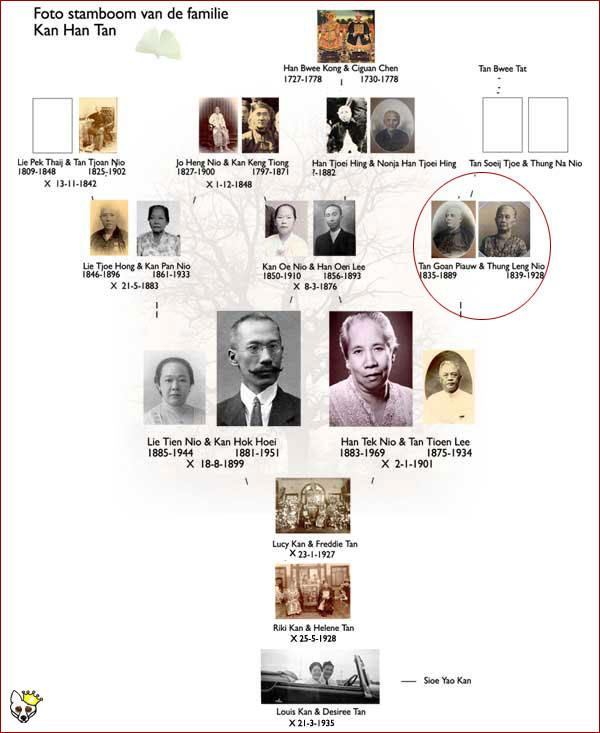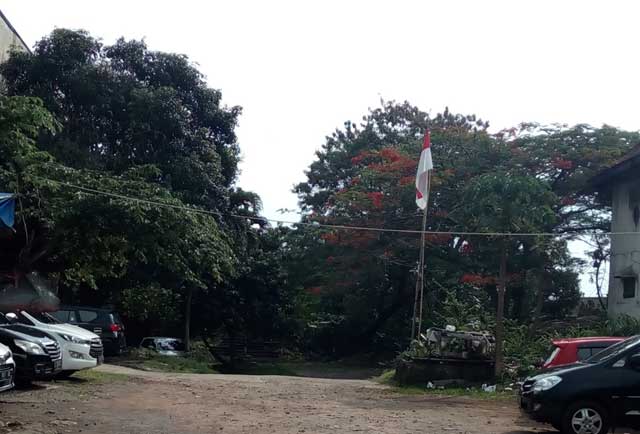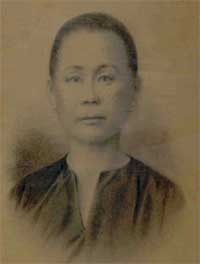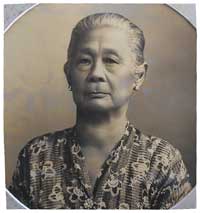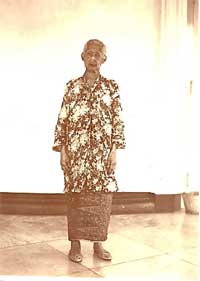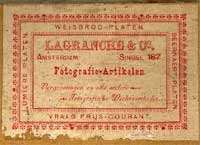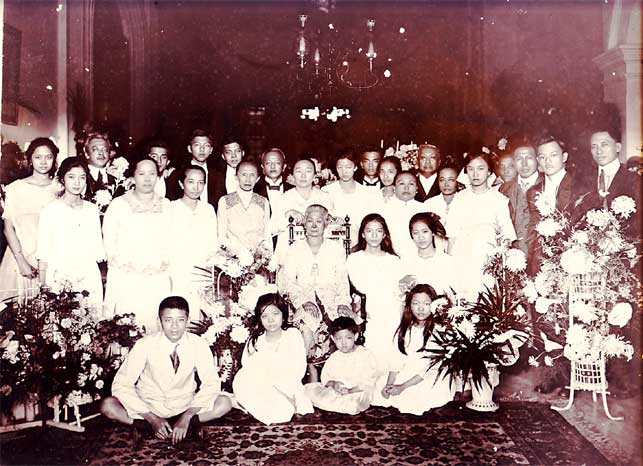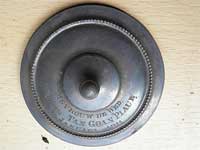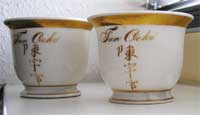Introduction |
||
Family name Tan (Chen in Mandarin) is among the most frequent Chinese names in Southeast Asia and in the Netherlands. This is to stipulate which Tan branch is at the base of our Kan-Han-Tan clan.
|
||
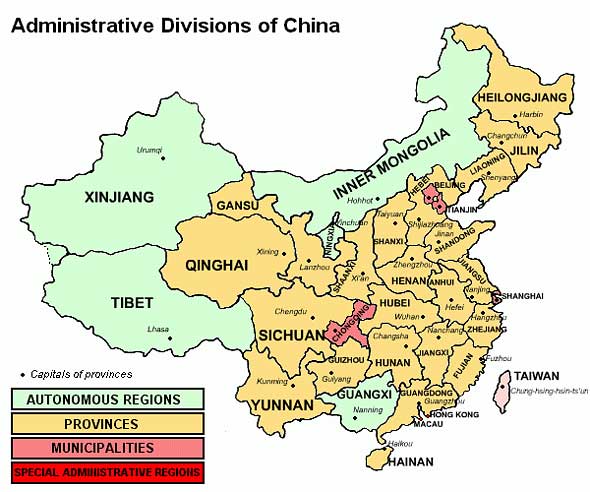 |
||
| The Jia Pu describes the situation around 1300. Presently no town or village with the name of Zhuangzou can be found in the county Anxi, though there is a village Zhuangzao [Hokk.: Tjeng Tjaw] near Longjuan. Cousin Tan Eng Swie and Danny Tjoa suspect that the author of the passage in the Jia Pu mistakenly used the character for zou instead of zao. Moreover the author would have used the character for township xiang instead of village cun. | ||
 |
||
| - | ||
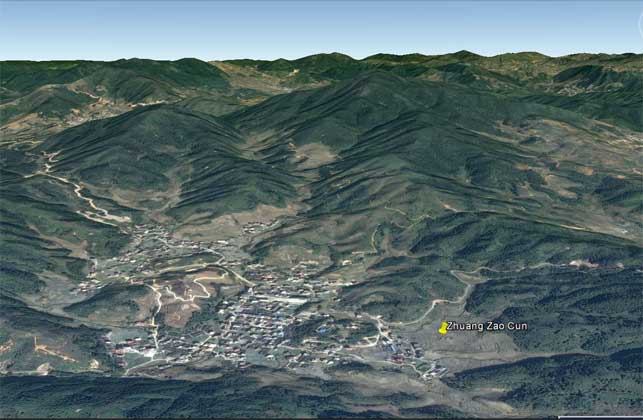 |
||
|
So Tjeng Tjaw is considered the place of origin of our Tan ancestors. |
||
|
Tan Tjong Tek married with Lie Koen Houw and had two sons. |
||
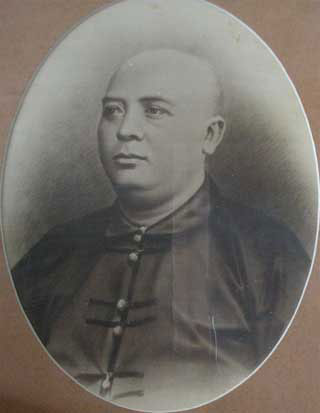 |
|
Tan Goan Piauw alias Tan Eng Tjoen is a descendent of Tan Ak Siap . He lived from 1835-1889 in Buitenzorg. He was the 15th generation of the Tan branch. |
Tan Goan Piauw had 4 sons and 3 daughters. |
||
Tan Goan Piauw and Gedong Dalam |
||
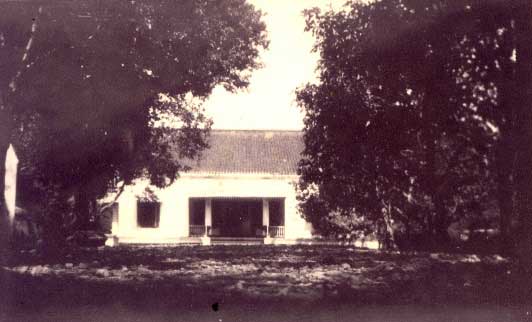 |
||
|
The Tan family home in Buitenzorg “Gedong Dalam” is built by Tan Goan Piauw. He had to consider restrictions (neighborhood) for Chinese which were stipulated by the government of the Netherland Indies. This meant that Chinese were to live in separate parts of town in typical Chinese houses. |
||
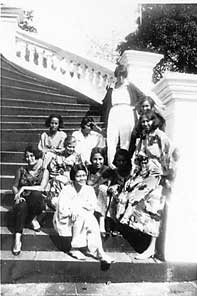 |
The front of Gedong Dalam appears as a typical Chinese house with an entrance in the middle. A roof parallel with the front with slightly upward sides. It was built bigger than any regular Chinese house in the camp and was decorated with marmor tiles and pillars. The back garden was declining down towards the river. As a result there was a difference in ground level between front and the rear of the house. This slope enabled at the back side of the house the construction of an additional floor underneath the ground floor of the front side, underneath the living quarters of the house. This part is therefore called the “Kolong”(cellar). |
|
| The ground floor at the front side became a kind of second floor at the backside and was connected by two large curved staircases on both sides in the style of Palladio. To get an impression of the scale of these staircases here a photo taken during an excursion of the Bataviasche Vrouwelijke Studenten Vereeniging (BVSV) at Gedong Dalam in July 1931. | ||
Such Paladio Style details in houses were reserved for white Europeans and actually at that time forbidden for Chinese. But these details were not visible from the street side. Later the building was enlarged both on left and right sides with an extension of the roof and an extra window and a porch above the front door. As a result the layout of Gedong Dalam resembles the form of a cross, quite in accordance to a Palladio Villa. |
||
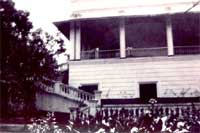 |
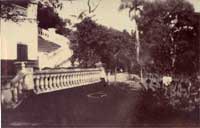 |
|||
|
Tan Goan Piauw and Thung Leng Nio lived in Gedong Dalam till their death. Thereafter descendants of Tan Tjoen Gie and Tan Goan Hoat lived there. Later followed by poor family members(?).
After the independence of Indonesia according to Hardi Sumawinata, a descendant of Tan Goan Hoat, Gedong Dalam was used by the Chung Hua Chung Hui. (Foto Tan Eng Swie en Hardi Sumawinata https://www.myheritage.com/site7538851/tanbogor) |
||||
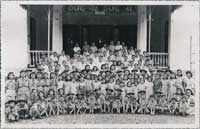 |
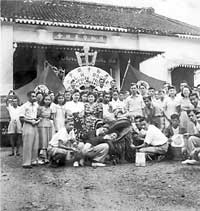 |
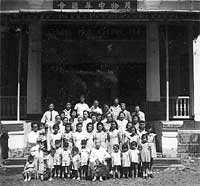 |
||
-click on photo's to enlarge- |
||||
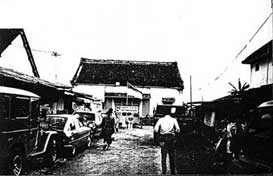
After the coup of 1965, Gedung Dalam was confiscated by the Indonesian Government. According to Mario’s blog was Gedong Dalam then used as a tax office. https://handelstraat.wordpress.com/2008/12/03/106/ . On the left photo the front of the building was closed with bars. Also two new buildings were built in the front garden. A shopping mall was planned by the daughter of Suharto and Gedong Dalam was flattened. But in the meantime Suharto was no longer president. Gedong Dalam, as can be seen on photos made this year, remained just as a ruin overgrown with trees and bushes and deprived of the marmor tiles and pillars. |
||||
|
|
||||
The original staircase at the entrance of the building. |
||||
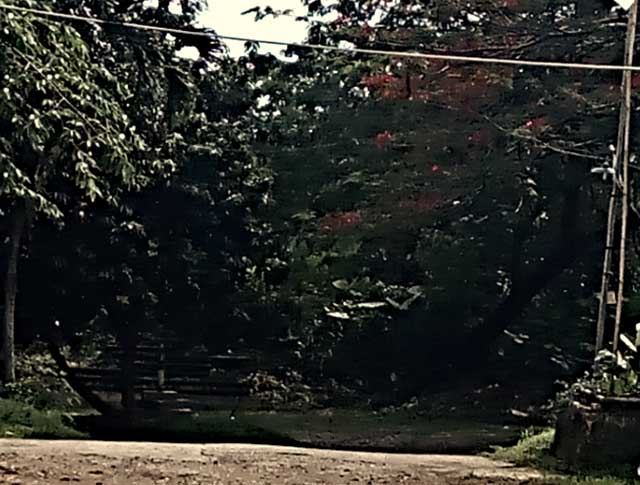 |
||||
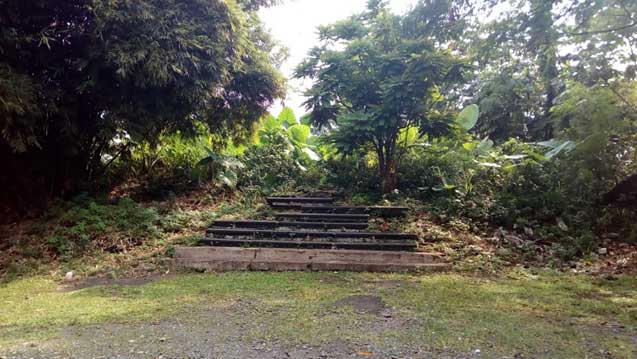 |
||||
Tan Goan Piauw a Chinese Officer |
||
Tan Goan Piauw is remembered in our family as "Captain China at Buitenzorg". |
||
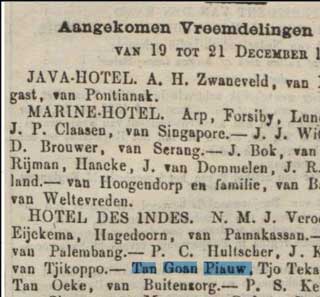 |
From the newspaper reports it seems that Tan Goan Piauw in his early officer days was already taken to Batavia by the other Chinese officers such as his uncle Tan Oe Ko. Tan Goan Piauw had the following officer functions: |
|
| Apparently since 1880 his Captains post was in decline as shown in newspaper reports of the Java Bode of 19 and 31 August 1880. | ||
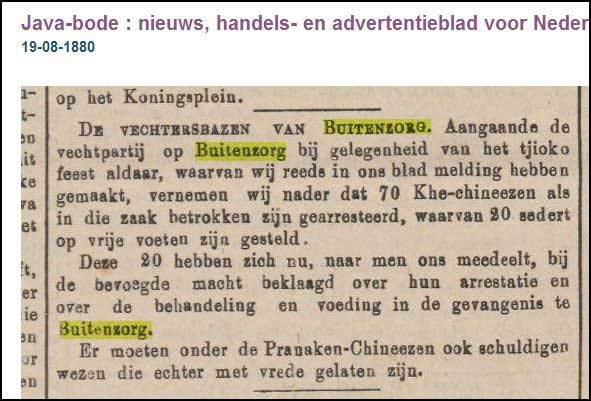 |
||
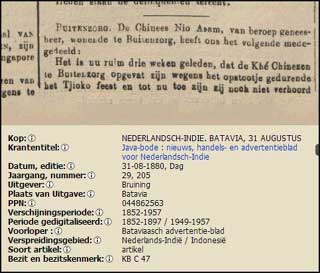 |
 |
|
|
In the family there could be another reason for this early end of his Captaincy. Shortly after Tan Goan Piauw purchased the Tegal Waroe Landerijen, he was visited by the Resident of Buitenzorg. This Resident came to collect the alleged overdue debt payments of land tax for the previous years. After Tan Goan Piauw had shown the purchase contract dated on that same year, he was accused of counterfeiting the date of purchase. As a result Tan Goan Piauw in his anger slammed the marmor table blade they ware sitting by in two. The Resident was so shocked that he soiled his pants. As a revenge Tan Goan Piauw was accused of offending the Resident; in the newspaper came the story “a Chinese had offended the Resident”. Unfortunately this newspaper report has not yet been found in the historical newspapers nor in the Royal Library. |
||
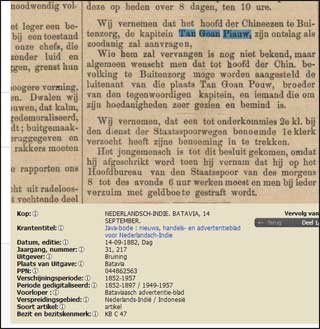 |
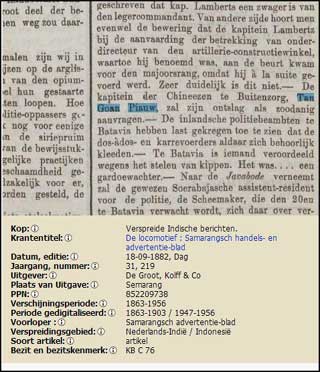 |
|
|
Shortly after that his retirement and nomination to Captain China Titular was reported. |
||
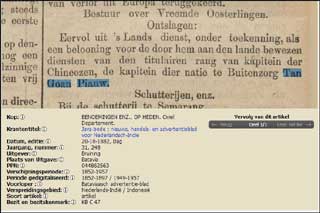 |
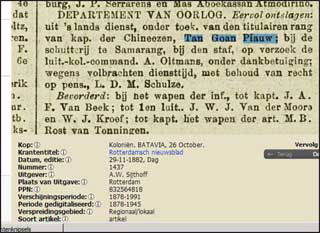 |
|
| Although the Kong Koan (Chinese Council) of Buitenzorg was disbanded during W.W.II, there was some still some kind of activity till 1967. The whereabouts of the Kong Koan Archives of Buitenzorg unfortunately is not known. | ||
Stories and Anecdotes’ about Tan Goan Piauw There are some stories about Tan Goan Piauw receiving a medal for pacifying an uprising. Tan Goan Piauw and education Tan Goan Piauw was progressive in his time. He took care that his 3 sons by Thung Leng Nio would be well educated in Dutch schools. |
||
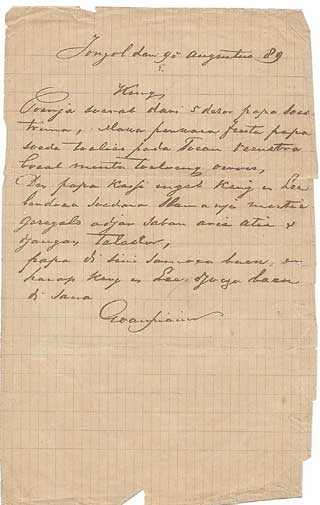 |
The two younger sons were sent to Batavia to secondary school (KW III) and stayed in the home of one of the teachers, Mr. Veenstra. |
|
This drive towards good education was obvious in the whole family. For example my grandmother, the wife of Tan Tjoen Lee always urged her grandchildren to score the highest marks at school. |
||
From the historical newspapers we know that Tan Goan Piauw has tried to combine Tjimangis with the Tegal Waroe Landerijen in one government unit of West Java. Possible reason for this move was the colonial agricultural politics, namely, after the opening of the Suez channel, the Preanger Residence was for European planters only . |
||
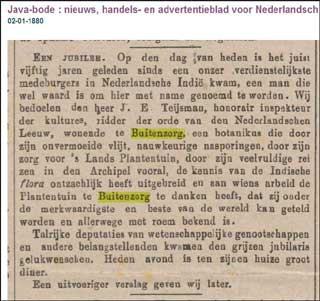 |
Tan Goan Piauw was in close contact with the people of ‘s Lands Plantentuin (Botanical Garden) in Buitenzorg as his house Gedong Dalam was situated along that garden. An article from the “ Natuurkundig Tijdschrift voor Nederlandsch Indie” gives an account of a festival on the occasion of the jubilee of mr. Johannes Elias Teijsmann, hortulanus, who on the 2-1-1880, had stayed for 50 years without a break in Netherlands Indies and was for 38 years connected to the Hortus: | |
“At the end Mr. Teijsmann invited all people to move to the backside of his house to view a spectacular fireworks offered to him by one of his oldest friends, the Captain China Tan Goan Piauw, that was ignited by another of his oldest friends, Lieutenant China Tan Goan Pouw, in his garden illuminated with beautiful Chinese lanterns.” |
||
| This jubilee festival was also reported in the Java bode of 2-1-1880. | ||
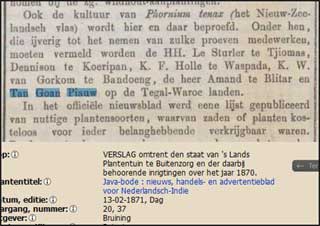 |
In this way he was in contact with various persons who experimented with plants/harvests, as we can see in the newspapers. |
|
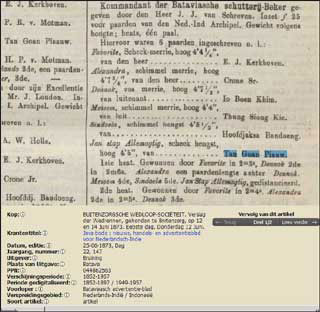 |
||
|
Also from the historical papers we can read that Tan Goan Piauw was involved in the “Buitenzorgsche Wedloop Societeit” and that he was frequently running his own horses, Bintang a white gelding horse and Jan Stap Allemachtig a Scheck horse. |
||
| An art historian of the Municipal Museum of Den Haag was introduced in my grandmother’s home (widow of Tan Tjoen Lee) by the Dutch Embassy when she was in search of VOC silver. She discovered a silver VOC plate on the ancestor table (aboe-table). This plate along with other silver plates was used to place food and fruit on the ancestral altar. My grandmother told us that this plate was donated by the Governor General to Tan Goan Piauw thanking him for his services. Unfortunately we could not find evidence for this in newspapers. | ||
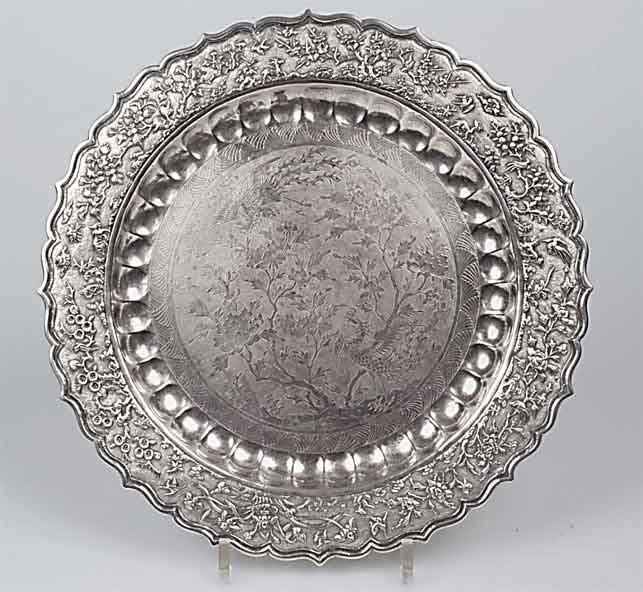 |
||
On 11-5-1876 he made his will from which we learned about his wife and his second wife (bina moeda) and his natural son Tjoen Gie and his three heirs Tjoen Liang, Tjoen Keng, Tjoen Lee. This will is kept by Tan Eng Swie and we were allowed to copy it.” |
||
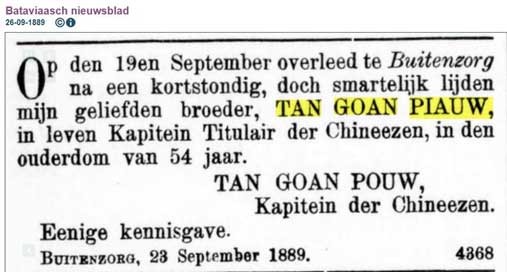 |
||
Tan Goan Piauw died on the 19th of September 1889 in Buitenzorg at the age of 54 years. |
||
 |
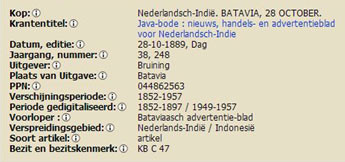 |
|
He was buried with pomp and grandeur in accordance with his position of Captain China on the 27th October 1889. |
||
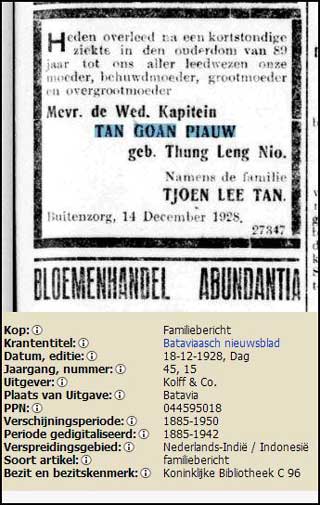 |
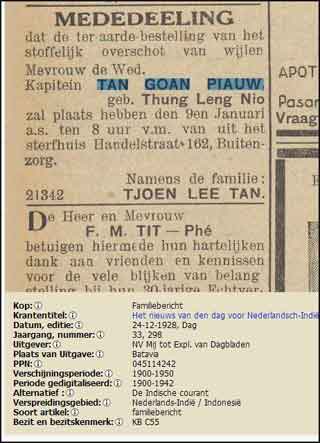 |
|
We have a photo of her deathbed. |
||
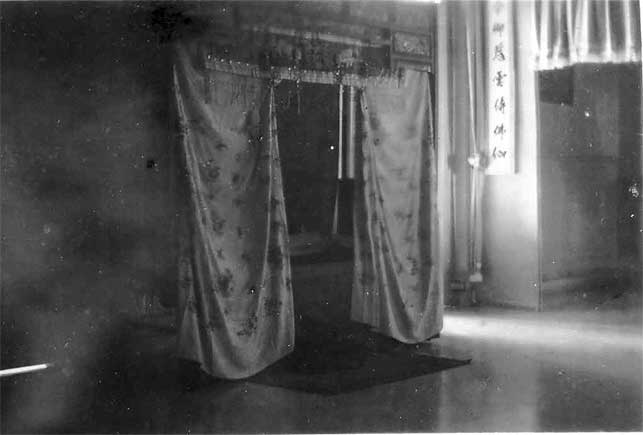 |
||
|
Also the klamboe, curtains and bed-ribbons are conserved. |
||
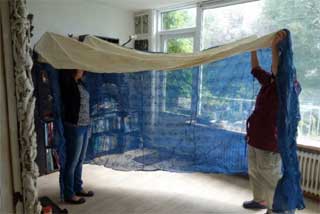 |
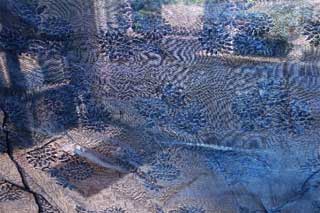 |
|
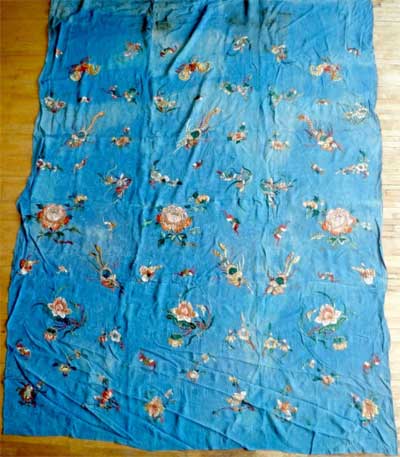 |
||
 |
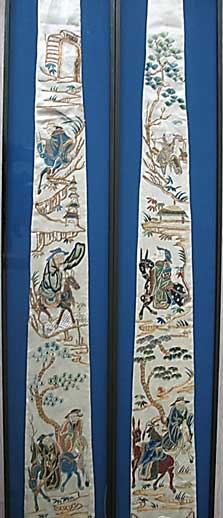 |
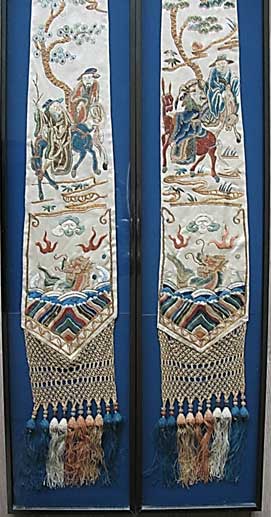 |
||
Photos have been made of the decoration of her coffin. |
||
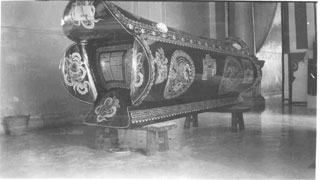 |
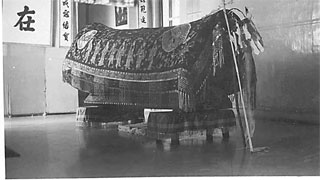 |
|
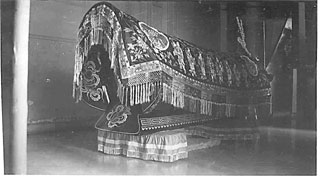 |
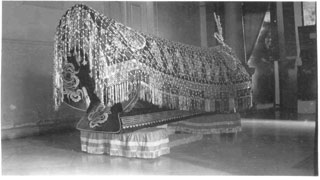 |
|
| Decoration of the coffin with flowers was as follows: | ||
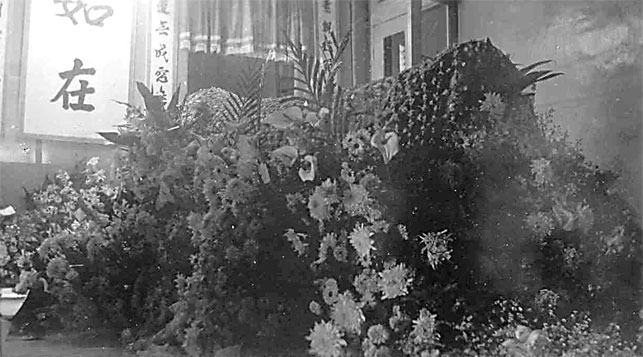 |
||
|
First an embroidered cloth with the 8 immortals was draped on the coffin. The following pictures give an impression of the burial procession: |
||
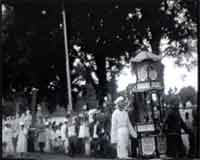 |
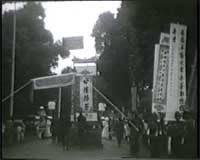 |
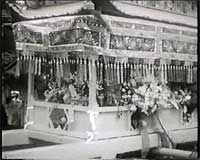 |
||
|
The grave of Tan Goan Piauw and Thung Leng Nio |
||||
| We used to visit the graves in Bogor every year during the Tjeng Beng. This was a real festivity each year. First there was the food shopping at a member of the Tan family who lived in the Djalan Perdagangan (jl. Suryakencana). | ||
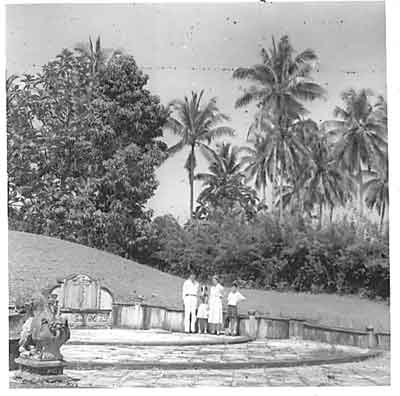 |
At the burial place we were attended by the village head who addressed my grandmother with the title “Djoeragan” (land owner). There were always some small boys who would climb the palm trees to fetch some young coconuts for its milk. After cleaning the graves, lighting the incense sticks and symbolically sacrificing food to our ancestors by putting it in front of the Bongpais, we dined together (in thought) with our ancestors. |
|
This tradition was stopped abruptly in 1962. In that year we had to exhume our ancestors near Djakarta because the burial grounds were dispossessed on the occasion of the construction of the Djakarta Bypass. |
||
| Though the graves near Bogor were not in direct danger, my grandmother, the widow of Tan Tjoen Lee (Han Tek Nio) had exhumed all graves near Bogor, that is the grave of Tan Tjoen Lee and her son Ferry, and also that of Tan Goan Piauw and his wife Thung Leng Nio. |
||
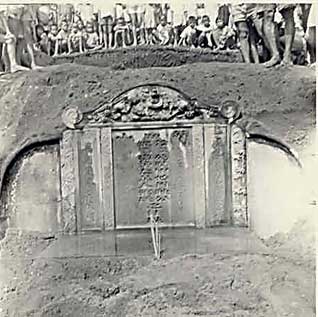 |
The photo on the left shows the grave of Tan Goan Piauw and Thung Leng Nio during the exhumation. The burning of incense sticks is to warn the spirits about the exhumation. |
|
|
|
||
Epilogue |
||
As a reaction on this website we received some photos about an old house. This house is also situated at the Handelsstraat (jl. Suryakencana no 210) and it is known in Bogor as ”the old house of the Captain - Tan”. In an excerpt of a script of Krishta Paramita Kurnadi http://www.heibogor.com/post/detail/25791/suryakencana-dan-rumah-tua-kapitan-tan/#.WeZU2YikKUk it was stated that with “the captain-Tan”, Tan Goan Piauw is meant. |
||
So some new puzzle pieces have to be positioned. Will be continued |
||
| Although there are still no answers for the above questions, the architectural style of the building being definitely after 1900 excludes the option that Tan Goan Piauw had ever lived in this house. | ||
| Berkel, Updated August 2018 | ||
| Sioe Yao Kan | ||


